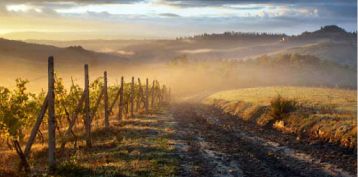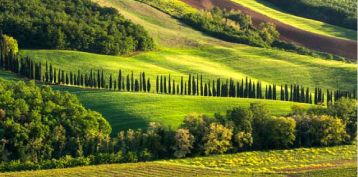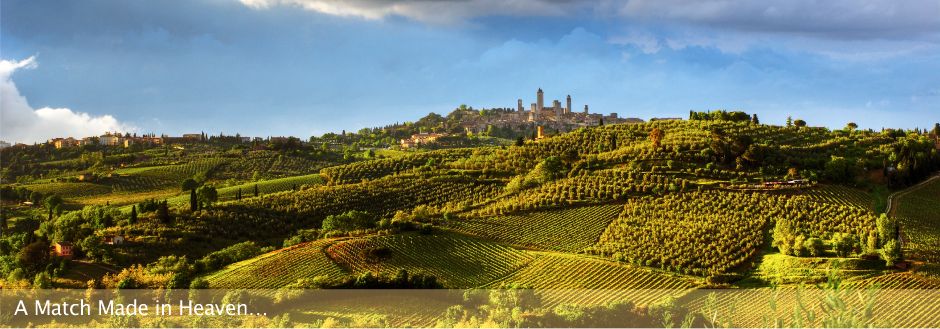| Wedding planner | Settings | Ceremonies | Locations | Services | Wedding guests | Lodgings | Reviews | Contacts |
Locations
Our locations are a selection of medieval hilltop towns in Tuscany Italy adorned with incredible art treasures and surrounded by spectacular natural landscapes. Our philosophy is to avoid big chaotic towns in order to soak up the magic atmosphere of local villages and charming small towns.
The natural setting of your wedding will be the gorgeous Tuscan countryside, where you can enjoy the peace and the tranquillity of this much sought after region.
Chianti
 The Chianti area is famous for its hilly landscape which is among the most enchanting in this region thanks to the genuine charm of its vineyards and olive groves immersed in pure light and serenity. Sometimes, at dawn, a hazy mist wraps up the region and a dream-like atmosphere softens and enhances the view of the dark slender outlines of cypresses or of the domestic architecture of old Medieval villages and country villas. The true expression of the region is the Chianti wine, the well-known red wine appreciated all over the world.
The Chianti area is famous for its hilly landscape which is among the most enchanting in this region thanks to the genuine charm of its vineyards and olive groves immersed in pure light and serenity. Sometimes, at dawn, a hazy mist wraps up the region and a dream-like atmosphere softens and enhances the view of the dark slender outlines of cypresses or of the domestic architecture of old Medieval villages and country villas. The true expression of the region is the Chianti wine, the well-known red wine appreciated all over the world.
HISTORY
The origin of the name "Chianti" is probably Etruscan. Documents are very fragmentary and this makes the reconstruction of the history quite difficult. It was the Etruscans who first left traces of their civilization. After the Etruscans, the Romans settled there and built fortresses.
The long-lasting struggle between Siena and Florence also involved this region. Both towns wanted to get control of the area. After ups and downs, the two cities signed a peace agreement in 1201 but the hostilities did not end soon. Only in 1859, after the Unification of Italy, Radda, Gaiole and Castellina came under control of Siena.
There is an interesting legend. To decide about the boundaries, the two towns established that at crock-crow two horse-men would start galloping and would stop only when meeting his rival. The town would become the owner of the land ridden across by its horse-man. The day before the race, the Florentine starved a black roster which crowed before dawn and woke up the knight much earlier than the Sienese one. Florence managed to annex the largest part of the Chianti.
MAIN FEATURES
In the 18th C. the area near the villages of Gaiole, Castellina and Radda was defined as Chianti and also the wine produced there had the same name. In 1932 the Chianti area was divided into: Classico, Colli Aretini, Colli Fiorentini, Colline Pisane, Colli Senesi, Montalbano and Rùfina. The history of Chianti wine is as complicated as the history of its land. Several important changes have alternated with crises but Chianti wine is now famous all over the world and Chianti Classico is often the protagonist on important occasions. Since the late sixties the land devoted to wine has been enormously expanded and nowadays it covers a vast region. Among vineyards, olive groves and woods, there are places of great artistic and historical importance. The roads are so intertwined that it is easy to find small villages, parish churches or castles. Most paths are of great historical and environmental interest. In the region there are many historical cellars, and a tour of the region must include a visit to a Chianti castle or to a hilltop village, where you can have a delightful wine-tasting whilst enjoying charming panoramic views of the Tuscan hills.
MAIN SIGHTS
 Castles are undoubtedly worth a visit: Briolio, Volpaia, Cacchiano, Cerreto, Meleto, Bossi, Vertine, just to mention some of them. Ancient Parish Churches such as St. Pietro a Bugialla, S. Maria Novella, St. Leonino, St. Appiano and also the Parish Church of San Marcellino (the romans settled there as shown by an important necropolis discovered nearby and by some capitals and columns kept in the old Church). And then the villages lying among vineyards and olive groves or standing on top of green hills: Greve in Chianti (with the beautiful funnel-shaped Piazza Matteotti, Palazzo Municipale and the Superior Church of Santa Croce), Montevertine and its Piccolo Museo del Chianti, Panzano – famous for its embroideries, Castellina in Chianti with its high Rocca and Via delle Volte (the oldest and most suggestive street of the village), Gaiole in Chianti, Radda in Chianti and Vertine (a splendid castle-village which owes its importance to the Ricasoli family where you can still visit the ruins of the walls).
Castles are undoubtedly worth a visit: Briolio, Volpaia, Cacchiano, Cerreto, Meleto, Bossi, Vertine, just to mention some of them. Ancient Parish Churches such as St. Pietro a Bugialla, S. Maria Novella, St. Leonino, St. Appiano and also the Parish Church of San Marcellino (the romans settled there as shown by an important necropolis discovered nearby and by some capitals and columns kept in the old Church). And then the villages lying among vineyards and olive groves or standing on top of green hills: Greve in Chianti (with the beautiful funnel-shaped Piazza Matteotti, Palazzo Municipale and the Superior Church of Santa Croce), Montevertine and its Piccolo Museo del Chianti, Panzano – famous for its embroideries, Castellina in Chianti with its high Rocca and Via delle Volte (the oldest and most suggestive street of the village), Gaiole in Chianti, Radda in Chianti and Vertine (a splendid castle-village which owes its importance to the Ricasoli family where you can still visit the ruins of the walls).
| Home page|Wedding planner|Settings|Ceremonies|Locations|Services|Wedding guests|Lodgings|Reviews|Contacts |

